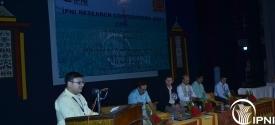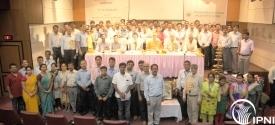Regional Profiles - East India & Bangladesh
Nutrient use and crop production statistics of the major states in East India & Bangladesh
Arunachal Pradesh is located in northeast India and borders the states of Assam and Nagaland to the south, sharing international borders with Bhutan in the west, Myanmar in the east and the People's Republic of China (PRC) in the north. Arunachal Pradesh is located between 26. 28° N and 29. 30° N latitude and 91. 20° E and 97. 30° E longitude. It has an area of 8. 3 million hectares and a population of 1. 3 million. Agriculture primarily drives the economy.
Assam is world famous for its tea; however, it also has a major role in the foodgrain production in India, especially in eastern India. Assam occupies a geographical area of 7. 8 million hectares of which total cropped area is 4. 0 million hectares. However, only 5. 4% of the gross cultivated area is irrigated and the average cropping intensity of the state is 145. 9%. The majority of the soils of Assam belong to Inceptisols (49. 3%), Entisols (32. 3%), Alfisols (12. 3%) and Ultisols (6. 1%).
The largest Eastern Indian state – Bihar lies in the north eastern part of India (between 24°20’11’’ and 27°31’15’’N latitudes and 83°19’50’’ and 88°17’40’’E longitudes) and occupies an area of 9. 4 million hectares, out of which total cropped area is 7. 5 million hectares. The state has a total population of about 103. 8 millions with a density of 880 per sq. km. Annual foodgrain production is 11. 9 million tonnes (Mt), with an average productivity of 1460 kg/ha.
 IPNI Research Cooperators' Meet 2016
IPNI Research Cooperators' Meet 2016The 4th IPNI Research Cooperators Meet was organized at Visva Bharati University Sriniketan, West Bengal, incollaboration with Visva Bharati University. The program begins on April 8th with the inaugural session. Prof. Swapan Datta, Honorable Vice Chancellor, Visva Bharati was the chief guest of the inaugural session while Dr. Adrian Johnston, Vice President, IPNI presided over the session. Dr. Kaushik Majumdar, Director, IPNI delivered his context setting lecture while Prof.
Jharkhand is the most recently developed state so far in eastern India. Earlier it belonged to the state Bihar; and is formed by separating the southern part of Bihar, on 15th November 2000. Jharkhand has an area of 7. 97 million ha and has a population of 32. 96 million, 28% of which consists of tribal people. The state is very famous for its mineral resources. Table 1 illustrates the current area, productivity and production statistics of major crops in Jharkhand.
Manipur is a state in north-eastern India. It is one of the seven states of Northeast India. The state is bound by Nagaland in the north, Mizoram in the south, Assam in the west, and by the borders of the country Myanmar in the east as well as in the south. Manipur lies at latitude of 23°83’N – 25°68’N and longitude of 93°03’E – 94°78’E. The total area covered by the state is 2. 2 million hectare and a population of 2. 7 million as per 2011 census.
Meghalaya is a state in the north-east India and means "the abode of clouds" in Sanskrit and other Indo-Iranian languages. As of 2011, the state has a population of 2. 96 million and is the 23rd most populous in the country. Meghalaya covers an area of approximately 2. 2 million hectares. This state is surrounded in the north by Assam and by Bangladesh in its south.
Mizoram is one of the Seven Sister States of the North Eastern India, sharing borders with the states of Tripura, Assam, Manipur and with the neighbouring countries of Bangladesh and Myanmar. Mizoram became the 23rd state of India on 20 February 1987. The state covers an area of 2. 1 million hectare and has a population of approximately 1. 09 million. Around 60 per cent of the population of the state depends on agriculture.
Nagaland is a state in the far north-eastern part of India. It borders the state of Assam to the west, Arunachal Pradesh and part of Assam to the north, Myanmar to the east and Manipur to the south. It has an area of 1. 65 million hectare with a population of 1. 98 million as per the 2011 census, making it one of the smallest states of India. Agriculture is the most important economic activity in Nagaland, with more than 90% of the population employed in agriculture.
 National Seminar on Soil Health Management and Food Security: Role of Soil Science Research and Education
National Seminar on Soil Health Management and Food Security: Role of Soil Science Research and EducationDr. Sudarshan Dutta, Deputy Director, IPNI South Asia, and the Indian Society of Soil Science Kolkata Chapter jointly organized the National Seminar on "Soil Health Management and Food Security: Role of Soil Science Research and Education," held in Kolkata, October 8-10. The successful event, which coincides with the 2015 International Year of Soils, featured 13 distinguished speakers and nearly 200 participants including scientists, extension professionals, industry agronomists, and farmers.
Tripura is a state in North East India. It extends from 22°56'N to 24°32'N, and 91°09'E to 92°20'E. The third-smallest state in the country, Tripura covers 1. 04 million hectare and is bordered by Bangladesh to the north, south, and west, and the Indian states of Assam and Mizoram to the east. As of 2011 census, the state has 3. 6 million residents, constituting 0. 3% of the country's population.
West Bengal is one of the most important states of eastern India. The state capital i. e. Kolkata is so far the only metropolitan city and therefore the biggest business hub of eastern India. Geographically this is also a very important state as lying between 21°25'24” and 27°13'15” north latitudes and 85°48'20” and 89°53'04” east longitudes, the State of West Bengal shares its borders with three different nations – Bangladesh, Bhutan and Nepal – and four other Indian States, viz.
Nutrient Expert® is a computer based fertilizer decision support tool that provides balanced fertilizer recommendations in the absence of soil test information. Nutrient Expert® for Wheat (NE – W) helps wheat farmers to follow the 4R Nutrient Stewardship Principles of applying the right source of nutrient, at the right rate, at the right time and at the right place.
